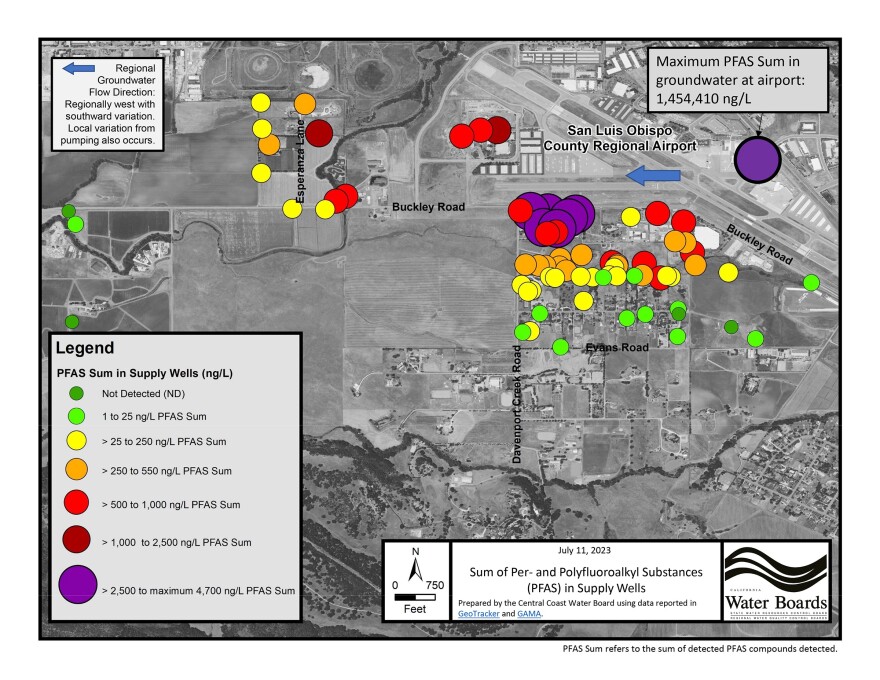Toxic chemicals have been leaking into the groundwater under and around the San Luis Obispo County Regional Airport for about five decades. It’s not the only airport in the state dealing with this contamination, but it is the first to address the problem with a formal plan.
That’s because the contamination impacted dozens of private wells for homes and businesses. Many affected residents feel like the process is moving too slowly.
The Federal Aviation Administration requires hundreds of airports of all sizes to use a special foam to put out any fires. Here in SLO, firefighters began spraying what's called aqueous film forming foam (AFFF) during practice drills in the 1970s.
But the foam is full of harmful chemicals called per- and polyfluoroalkyl substances, or PFAS. They’re often called “forever chemicals” because they don’t break down in the environment.
Kathy Borland lives across the street from the airport.
“We've been here since [1983], so we don't have any idea how long we've been exposed to this," she said. "We just have no idea.
Beginning in 2019, the State Water Board ordered 30 airports in California to investigate PFAS contamination. According to the board, all of them showed some level of impact.
As for the SLO airport, a vast majority of the more than 70 wells in the area were contaminated. Many of them were private wells — including the one at Borland’s house.
Borland raised seven children at her home on Buckley Road. It’s a rustic property near a creek with a large vegetable garden. The houses in this area aren’t connected to a public water system: everyone’s on wells and septic tanks.
She found out last year that her well water is contaminated with high levels of PFAS. These chemicals are found in things like cookware, water-resistant clothes and food packaging. They resist grease, oil, water and heat, which is why they’re also found in firefighting foam.
Borland has filters to keep PFAS and other chemicals out of the water in her house. Even still, she drinks bottled water.
But she and her neighbors still irrigate their gardens with the contaminated well water.
“So we all have vegetable gardens out here, we all have fruit trees," she said. "Is there PFAS in our fruit? Is it coming up through the vegetables? Nobody can give us an answer."

According to the CDC, the chemicals can cause serious health problems like cancer, liver damage, high blood pressure, birth defects and more.
Borland has a history of liver damage, and said it’s urgent to fix her neighborhood’s water problems.
“We can't wait for them to figure this out, because we're all consuming PFAS,” she said.
SLO County and CalFire recently reached an agreement with the Central Coast Regional Water Quality Control Board to address the contamination. The agencies will provide water filters to residents who live near the airport.
But an official plan to clean up the contamination could be as long as three years out.
It’s a big undertaking, said SLO County Supervisor Dawn Ortiz-Legg.
"We're waiting for the rest of the data to come out on PFAS, as it is one of these chemicals that's used in multiple applications," she said. "And so without knowing more, it's hard to know what to do next, other than making sure that they have clean water."
Ortiz-Legg said she sympathizes with residents who feel the process isn’t moving quickly enough, but she called the agreement a “significant and meaningful milestone.”
"We're the first to actually find a resolution, at least a working resolution, towards creating safe drinking water for our constituents," she said.

Ortiz-Legg said one of the main challenges is the lack of data around PFAS contamination. Just this year the EPA proposed new federal standards.
Meanwhile, the FAA is trying to find an alternative to the firefighting foam. CalFire SLO said they don’t use it for training anymore, but they’re still required to use it in actual emergencies.
Mike Oliveira, who grew up in the area, feels the neighborhood should’ve been notified much sooner than they were.
"It's a worldwide problem we're experiencing right here in San Luis [Obispo] County," he said.
With relatives still in the area, he said the July agreement to provide filters and come up with a cleanup plan is a step in the right direction, but it’s still not enough.
“This is much too slow. Everything here needs to be done much faster," he said.
As the SLO airport begins to address the problem, the state water board said other airports with PFAS contamination could follow suit.
A public meeting on the contamination is scheduled for August 28 from 5:30 to 6:30p.m. at the Central Coast Regional Water Control Board building in San Luis Obispo.





